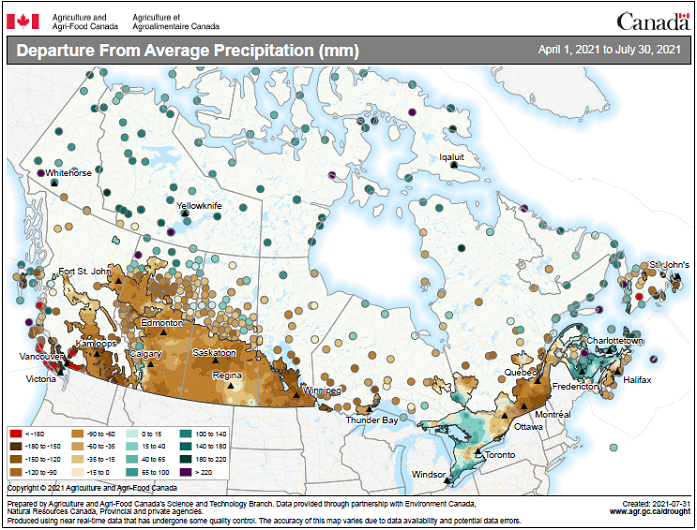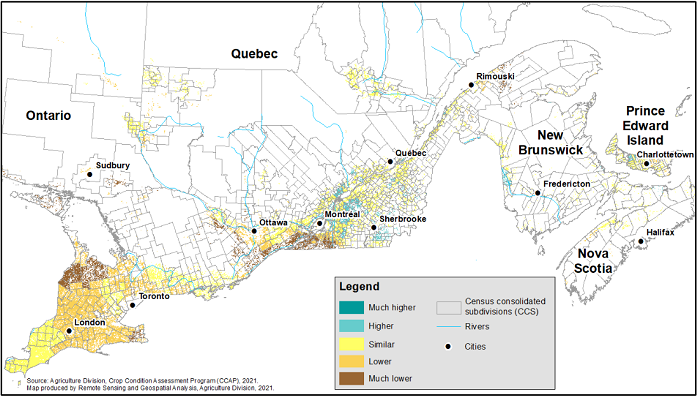Production of principal field crops, July 2021
Archived Content
Information identified as archived is provided for reference, research or recordkeeping purposes. It is not subject to the Government of Canada Web Standards and has not been altered or updated since it was archived. Please "contact us" to request a format other than those available.
Released: 2021-08-30
Canadian farmers are projected to harvest more corn for grain, but less wheat, canola, soybeans, barley and oats, according to recent yield models using satellite imagery. Lower production has been driven largely by ongoing drought conditions in Western Canada, which could decrease yields.
Farmers across Western Canada have had to contend with a lack of rain and higher-than-average temperatures throughout the growing season. This has exacerbated soil moisture conditions, which were already low at the start of the year. These factors have negatively impacted crop growth and yield potential across much of the Prairies.
Statistics Canada has relied upon proven satellite technology to model preliminary crop yields and production since 2016. These methods have successfully been used to produce September yield estimates since 2016, and they replaced July yield estimates beginning in 2020. While dry conditions may lead to an increase in abandoned acres, coarse resolution-based modelling relies on historical averages for harvested area. Final harvested area estimates will be published on December 3, 2021, based on the November 2021 Field Crop Survey.
The Crop Condition Assessment Program (CCAP) indicates that overall plant health in Western Canada was lower to much lower than normal, having decreased considerably throughout the month of July. This indicates the likelihood of lower-than-normal yields.
An assessment of Normalized Difference Vegetation Index (NDVI) curves, which are a measure of plant health, indicated that in almost all parts of the Prairies, crops reached peak health well ahead of normal. In some instances, peak NDVI occurred up to four weeks earlier, before decreasing rapidly as a lack of moisture and high temperatures took a toll on plant health.
This is the first time since 1987, when Statistics Canada began monitoring crop conditions using coarse resolution satellite images, that NDVI curves have peaked so early in the growing season. The CCAP also indicates that dry conditions have impacted almost all of Western Canada. By comparison, other notable droughts such as in 2002—while difficult for many—were less widespread than this year's. In Eastern Canada, the CCAP is similar to average, as parts of Ontario and the Maritimes received higher-than-normal rainfall, while most of Quebec remains drier than average.
Wheat production expected to decrease on lower harvested area and yields
Nationally, wheat production is projected to decrease 34.8% year over year to 22.9 million tonnes in 2021, on lower anticipated yields (-28.7% to 37.2 bushels per acre) and less harvested area (-8.5% to 22.7 million acres).
The decrease in wheat area was largely attributable to spring wheat, which in addition to having less seeded area in 2021, has been impacted by drought conditions in Western Canada.
Durum wheat yields are also expected to fall considerably, while winter wheat, which is predominantly grown in Ontario, is expected to yield in line with historical averages thanks to better growing conditions within the province.
In Saskatchewan, wheat harvested area is expected to fall 7.9% to 11.8 million acres, while yields are anticipated to decrease 33.8% to 30.4 bushels per acre to bring total wheat production down 39.1% year over year to 9.7 million tonnes.
Wheat yield in Alberta is expected to decrease 41.0% to 32.9 bushels per acre in 2021, while harvested area is projected to fall 7.0%, resulting in a 45.2% production decrease to 6.1 million tonnes.
Wheat production in Manitoba is projected to fall 24.1% to 4.0 million tonnes in 2021, the result of lower harvested area (-17.2% to 2.6 million acres) and lower yields (-8.3% to 56.2 bushels per acre).
Wheat production in Ontario (the majority of which is winter wheat) is projected to rise 8.9% to 2.7 million tonnes year over year, on increased harvested acres (+2.3%) and yields (+6.4%).
Lower anticipated yields push canola production to lowest level since 2012
Nationally, canola production is expected to fall 24.3% to 14.7 million tonnes in 2021, as drought conditions on the Prairies drove yields to their lowest level in a decade (-30.1% to 29.2 bushels per acre), offsetting higher harvested area (+8.1% to 22.2 million acres). If this were to happen, this would be the lowest canola production since 2012.
Canola production in Saskatchewan is expected to decrease 32.8% to 7.4 million tonnes. Lower yields (-36.8% to 27.0 bushels per acre) are expected to offset the increase in harvested area (+6.3% to 12.0 million acres).
In 2021, Alberta is expected to produce 14.0% less canola for a total of 4.5 million tonnes. Yields are projected to decrease 25.9% to 29.8 bushels per acre, while harvested area is expected to rise 16.0% to 6.6 million acres.
In Manitoba, yield is expected to fall 14.5% to 35.4 bushels per acre and harvested area to edge up 0.1% to 3.4 million acres, resulting in a 14.4% production decrease.
Corn for grain production projected to increase on higher yields
Nationally, corn for grain production is projected to increase 0.8% to 13.7 million tonnes in 2021, with yields anticipated to rise to 158.4 bushels per acre. Meanwhile, harvested area is expected to fall 2.3% to 3.4 million acres.
In Ontario, the largest corn for grain–producing province, production is expected to rise 1.7% to 9.1 million tonnes, on higher yields (+3.4% to 169.4 bushels per acre). This would offset lower harvested area, which is expected to fall 1.6% to 2.1 million acres.
Corn for grain production in Quebec is projected to rise 7.8% to 3.5 million tonnes. Yields are expected to increase 8.8% to 157.4 bushels per acres, while harvested area is expected to decline 0.8% to 880,300 acres.
Soybean production expected to fall despite greater harvested area
At the national level, soybean production is projected to decrease 8.4% year over year to 5.8 million tonnes in 2021. The main source of this decline is lower yields, which are expected to decrease 12.5% to 40.5 bushels per acre, while harvested area is anticipated to rise 4.8% to 5.3 million acres.
Farmers in Ontario are projected to produce 1.6% fewer soybeans in 2021 for a total of 3.8 million tonnes. Harvested area is expected to rise 3.2% to 2.9 million acres, while yield is anticipated to decrease 4.7% to 48.3 bushels per acre.
In Manitoba, soybean production is projected to decrease 30.8% to 804 700 tonnes in 2021, while harvested area is expected to increase 13.5% to 1.3 million acres. However, yields are projected to fall 39.1% year over year to 22.7 bushels per acre this year, due to dry conditions in the province.
In Quebec, soybean production is projected to decrease 8.0% to 1.1 million tonnes on lower yields (-12.0% to 42.6 bushels per acre), which will more than offset the projected 4.5% increase in harvested area.
Barley and oat production projected to fall due to dry conditions
Barley production is expected to fall 27.0% year over year to 7.8 million tonnes in 2021. Despite higher anticipated harvested area (+7.8% to 7.5 million acres), lower yields (-32.3% to 48.1 bushels per acre) due to hot, dry conditions are expected to push national production lower.
Oat production is projected to fall 32.9% to 3.1 million tonnes. Harvested area is expected to decrease 14.2% to 2.8 million acres and yields are expected to drop 21.8% year over year to 71.4 bushels per acre in 2021.
Note to readers
This release provides the preliminary production estimates for 2021, as well as revised production data for 2020, if applicable. The estimates are produced using model-based data.
The approaches used to produce these estimates are in line with the AgZero initiative underway at Statistics Canada, which aims to produce high-quality estimates using modelling, administrative data, and other non-traditional, survey-based approaches.
The Field Crop Reporting Series collects data from Quebec, Ontario, Manitoba, Saskatchewan and Alberta for all occasions during the crop year (from March to December). However, data are collected twice a year (in the June Field Crop Survey on seeded areas and in the November Field Crop Survey on final crop production) for Newfoundland and Labrador, Prince Edward Island, Nova Scotia, New Brunswick and British Columbia, which represent between 2% and 4% of national totals.
As of July 2014, July production estimates for these provinces are calculated using the final estimates of the last three crop years. The harvested area is first estimated based on the ratio obtained from the sum of harvested areas of the last three years to the sum of the seeded areas of the last three years. This average ratio is applied to their current year's seeded acreage from the June survey. This harvested area is then multiplied by the average yield of the last three years to estimate production.
Final production estimates for 2021 will be released on December 3, 2021, and are subject to revision for two years.
On September 14, 2021, Statistics Canada will release updated modelled yield and production estimates for field crops in Canada as of August 31, 2021. These data are derived from remote sensing, survey and agroclimatic data sources.
July model-based data were used to produce estimates of crop yield and production in Manitoba and Saskatchewan using parcel-level crop insurance data, while Alberta, Ontario and Quebec are modelled at the census agricultural region level. For more information on July's model-based data, please visit An Integrated Crop Yield Model Using Remote Sensing, Agroclimatic Data and Crop Insurance Data.
Additional data sources
Readers are invited to visit the Crop Condition Assessment Program web application, which is an additional tool to assess the growing conditions of field crops during the crop year. Readers can monitor a vegetation index of crop land on a weekly basis.
"Crop Reporting Survey at a Glance," an easy-to-print chart that provides an overview of the survey cycle, is now available.
Contact information
For more information, or to enquire about the concepts, methods or data quality of this release, contact us (toll-free 1-800-263-1136; 514-283-8300; STATCAN.infostats-infostats.STATCAN@canada.ca) or Media Relations (613-951-4636; STATCAN.mediahotline-ligneinfomedias.STATCAN@canada.ca).
- Date modified:







